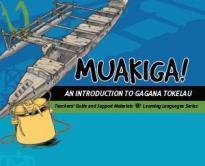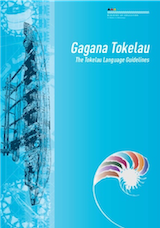You are here:
Overview
These teacher support materials accompany the six storybooks developed especially to support the Learning Languages Series resource Muakiga! An Introduction to Gagana Tokelau. Each story gives students opportunities to extend their language and cultural knowledge and to practise reading the target language of specific units in Muakiga!
These teacher support materials suggest how teachers can use the six storybooks to foster gagana Tokelau learning at levels 1 and 2, particularly in the context of the Muakiga! programme.
The teaching-as-inquiry cycle and the Newton et al. research
[1] on intercultural communicative language teaching underpin these teacher support materials. See:
Schools, ECE centres and education providers can order the set of six Muakiga! An Introduction to Gagana Tokelau storybooks from
Down the back of the chair. Enter item number MOE69797 into the search box.
Muakiga! An Introduction to Gagana Tokelau
Muakiga! is a resource in the Learning Languages Series. It provides a language-teaching programme that can be used by teachers, including those who do not speak gagana Tokelau or know how to teach languages. Muakiga! includes:
- twenty units of three lessons each
- a range of language suitable for years 7–10 at levels 1 and 2 of the curriculum
- video and audio support to engage learners and demonstrate how fluent speakers use the language
- lesson plans that could be linked to opportunities for learners to enjoy reading gagana Tokelau texts.
You can find Muakiga! online here.
Engaging students with texts
The teacher’s role is to mediate the interactions between the student and the learning materials
and enable the student to meet their learning outcomes.
Tauvāga Hiva Tokelau
by Mehepa Atoni Gaualofa
This story supports Unit 18: Hiva ma nā Fakafiafiaga (Performing Arts) in Muakiga!
Schools, ECE centres and education providers can order this storybook from
Down the back of the chair. Use item number MOE69704 in the search box.
Learning goals
Encourage your students to set one or more of the following learning goals for their work with this storybook. The learning activities support these goals.
I will use gagana Tokelau to:
- read the story and understand it
- read the story aloud with clear pronunciation and reasonable fluency
- recognise and use some words and expressions in different contexts
- write texts with macrons and correct spelling
- talk or write about the story.
I will use English to:
- understand the story when it is read aloud
- talk about the content of the written and visual texts
- give examples of how Tokelau language and culture are organised in particular ways
- make connections with the language(s) and culture(s) I know
- research and present information about Tokelau culture and values in the story
- make connections with my learning in Unit 18 of Muakiga!
Language and Cultural Knowledge strands
The Language and Cultural Knowledge strands at levels 1 and 2 of Learning Languages in The New Zealand Curriculum require students to:
- recognise that the target language and culture are organised in particular ways
- make connections with known languages and cultures.
The language and cultural features of the written and visual texts in the storybook are described here.
(a) Language Knowledge
The language features of the written texts include:
- different verb forms, for example, takalo / play (singular) and tākakalo / play (plural); hāvavali / walk (plural); hau / come (singular) and ōmamai / come (plural) – note that ōmai is an alternative plural form for ōmamai
- use of uma with two different meanings, for example, kua uma te ākoga / after school (that is, when school is finished); i taimi uma / all the time; and i vāiaho uma / every week
- words transliterated or borrowed from English, for example, netipolo / netball; Ēheta / Easter; Niu Hila / New Zealand; Auhetalia / Australia; and hall (in Tokelau these buildings are referred to by their names)
- formulaic expressions, for example, E hē kō mautinoa. / I’m not sure.; Io lā, kua lelei. / OK.; E lelei. / Of course.; Hōvē. / Perhaps.; and Tēnā i kō. / Over there.
- time expressions, for example, i te afiafi na hohoko / the next evening; i te pō nei / tonight; and toe tolu ia vāiaho / in three weeks’ time
- dance instructions, for example, Fakavavevave te hihiva! / Go faster!; Matafiafia! / Smile!
- words with the same letter combinations, where macrons distinguish meaning, for example, matua / older; mātua / mother, mum; and matuā / extremely
- vocabulary associated with music and dancing, for example, tā te apa / strike the tin; pō te pōkihi / beat the drum; and Hōhō ki mua! / Move forwards!
- different forms of pronouns to give precise meaning, for example, ki māua / us (dual); koe / you (singular); koutou / you (plural); and tātou / us (inclusive – all of you and I).
(b) Cultural Knowledge
The cultural features of the written and visual texts include:
- the movement of people between Tokelau and New Zealand. Many settle in New Zealand permanently and organise events where Tokelau people can meet and share their own culture. The Tokelau Easter Tournament is an example of this. This tournament takes place every two years in some part of New Zealand. Groups come from other countries to participate in the competitions, which include sporting competitions as well as musical and dance events.
- different words for Easter, because of different missionary influences. Ēheta is the Protestant term for Easter. Catholics use the terms Pāheka or Pāhekate, which are transliterations of the English word “Paschal” (Passover).
- information that extends students’ learning about dance group preparations. This includes the process of selecting the best dancers for the group to perform in the competition, and the prestige of being selected for the first row. It also includes references to the music provided by the apa (drums made from empty biscuit tins) and pōkihi (square bass drums). Tokelau dance lines are made up of age groups, for example, young single women dance in the same line, young married women in another line, and the older married women in yet another line. Where there are two lines of the same age group, a front line of the best dancers is necessary. See Muakiga! Unit 18, pages 409–410, for more information on Tokelau performing arts.
- ways of addressing parents, for example, Mami as an equivalent to “Mum” in English.
Communication strand
Students learn to apply their language and cultural knowledge in different contexts and situations to communicate effectively for a range of purposes. As they become more effective communicators, students develop the receptive skills of listening, reading, and viewing and the productive skills of speaking, writing, and presenting or performing. These are summarised on the
Learning Languages wall chart.
(a) The New Zealand Curriculum
The achievement objectives in learning languages,
levels 1 and 2 are generic.
In selected linguistic and socio-cultural contexts students will:
- receive and produce information
- produce and respond to questions and requests
- show social awareness when interacting with others.
(b) Gagana Tokelau: The Tokelau Language Guidelines
These
guidelines offer achievement objectives that are more specific. You could use any of the following levels 1 and 2 achievement objectives to narrow the focus for your students to help them achieve particular competencies. In selected linguistic and socio-cultural contexts students will:
- make requests, give instructions, and respond to requests and instructions (2.7)
- communicate interest, enjoyment, and need (2.3)
- use language, positioning, and movement to show respect (1.8).
(c) Muakiga! An Introduction to Gagana Tokelau
The Unit 18 learning outcomes for students are sharply focused. Students will:
- give and respond to instructions.
Cross-curricular links
Learners who are working at levels 1 and 2 in gagana Tokelau will be working at higher curriculum levels in other learning areas. Here are three examples of cross-curricular achievement objectives that could be linked to this story when you are planning links across curriculum learning areas.
The Arts, Level 3
Dance
Students will:
- explore and describe dances from a variety of cultures
- prepare and share dance movement individually and in pairs or groups.
Music
Students will:
- identify and describe the characteristics of music associated with a range of sound environments, in relation to historical, social, and cultural contexts.
Social Sciences, Level 3
Students will gain knowledge, skills, and experience to:
- understand how the movement of people affects cultural diversity and interaction in New Zealand.
Technology, Level 3 (Characteristics of Technology)
Students will:
- understand how society and environments impact on and are influenced by technology in historical and contemporary contexts and that technological knowledge is validated by successful function.
Values
The story illustrates the values of:
- community and participation for the common good
- respect for themselves and others.
See page 10 in
The New Zealand Curriculum.
In addition, students will come to appreciate how the story reflects core Tokelau values of fakaaloalo (respect), māopoopo (inclusion), and vā feāloaki (relating to others). See pages 8–9 in
Gagana Tokelau: The Tokelau Language Guidelines.
[1] Newton, J., Yates, E., Shearn, S., and Nowitzki, W. (2009).
Intercultural Communicative Language Teaching: Implications for Effective Teaching and Learning. Wellington: Ministry of Education.
Back to top ^


